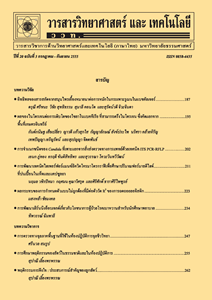การศึกษาความเป็นไปได้ของการผลิตแผ่นฟิล์มยางธรรมชาติโดยการฉายรังสีลำอิเล็กตรอน
Main Article Content
Abstract
บทคัดย่อ
งานวิจัยนี้มีวัตถุประสงค์เพื่อศึกษาผลกระทบทางสิ่งแวดล้อมและความเป็นไปได้ทางเศรษฐศาสตร์ของการฉายลำอิเล็กตรอนในการเชื่อมโยงพันธะระหว่างคาร์บอนกับคาร์บอนสำหรับการผลิตแผ่นฟิล์มยางธรรมชาติ ซึ่งวิธีดังกล่าวจะถูกนำมาเปรียบเทียบกับการผลิตด้วยวิธีดั้งเดิมที่ใช้สารเคมี โดยเปรียบเทียบคุณสมบัติทั้ง 3 ด้าน ได้แก่ การประเมินผลกระทบศักยภาพในการทำให้เกิดภาวะโลกร้อนโดยใช้วิธีการประเมินวัฏจักรชีวิต การประเมินต้นทุนทางเศรษฐศาสตร์ และคุณภาพทางกายภาพด้วยการการทดสอบแรงดึง อีกทั้งงานวิจัยนี้ยังศึกษาถึงผลกระทบของปริมาณการฉายรังสีที่ 50, 100, 150 และ 250 kGy โดยพิจารณาหน่วยหน้าที่คือ ผลิตภัณฑ์แผ่นฟิล์มที่มีน้ำหนัก 38.5 กรัม ผลการศึกษาพบว่าผลกระทบทางสิ่งแวดล้อมของการผลิตแผ่นฟิล์มยางธรรมชาติแบบดั้งเดิมและแบบการฉายรังสีคือ 0.13 และ 0.006 kgCO2e ตามลำดับ ส่วนต้นทุนในการผลิตแผ่นฟิล์มยางธรรมชาติของทั้งสองวิธีมีค่าใกล้เคียงกันคือประมาณ 4 บาท โดยการฉายลำอิเล็กตรอนจะมีต้นทุนสูงกว่าเล็กน้อยเมื่อเพิ่มปริมาณรังสีจนถึง 250 kGy ค่าการทนต่อแรงดึงจะเพิ่มขึ้นเรื่อย ๆ จนถึง 16.2 MPa ซึ่งน้อยกว่าแผ่นฟิล์มด้วยวิธีดั้งเดิมที่มีค่าการทนต่อแรงดึงคือ 22 MPa ทั้งนี้ผู้วิจัยคาดว่าสมบัติทางด้านแรงดึงจะสูงขึ้นเมื่อเพิ่มปริมาณรังสีจากขอบเขตของงานวิจัยนี้ แต่อาจจะนำไปสู่ผลเสียต่อความเป็นไปได้ทางเศรษฐศาสตร์
คำสำคัญ : รังสีลำอิเล็กตรอน; ศักยภาพในการทำให้เกิดภาวะโลกร้อน; หลักการประเมินวัฏจักรชีวิต
Abstract
This research aimed to investigate the environmental impact and economic feasibility of using electron beam to enhance carbon-carbon bonding for latex thin film forming process. This electron beam processing was compared with the chemical conventional one. LCA method, by global warming potential, was used to assess the environmental impact of both two processes. Operating cost was collected to determine economic worth of both methods. Physical properties, tensile stress for this case, were used to compare the quality of the products from both processes. Additional, four level irradiation of electron beam; 50, 100, 150 and 250, was adjusted to investigate effect of them. From data collection and experimental result showed that, the environmental impact of 38.5 g functional unit latex film obtained from conventional process and developing process were 0.13 and 0.006 kgCO2eq, respectively. Whenconsidering to operate cost of both processes, it was found that, the cost of both processes were almost quite similar at approximately 4 Bahts (slightly higher for electron beam process). Increasing of irradiation energy would exhibit increasing of tensile strength properties. However, product from electron beam irradiation process, at the maximum irradiation of this experiment (250 kGy), has tensile strength properties (16.2 MPa) worse than from chemical conventional process (22 MPa). Researchers expected the better result if more energy is increased further than boundary of this experiment, but this would brought disadvantage of economic feasibility.
Keywords: electron beam; global warming potential (GWP); life cycle assessment (LCA)


